CHAPTER XXI, Part TWO.
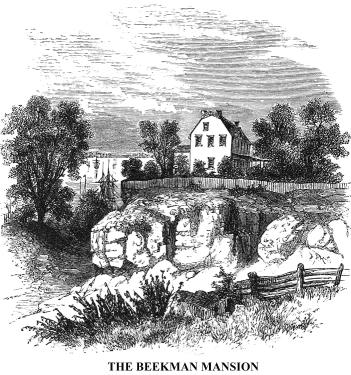 The
old Beekman mansion, with its rural surroundings, remained uninvaded by the
Commissioner of Streets until about ten years ago. I remember with pleasure
a part of the day that I spent there with the hospitable owner. Then there
were fine lawns, with grand old trees, blooming gardens, the spacious conservatory
in which Hale was confined, and an ancient sun-dial that had marked the hours
for a century. Over the elaborately-wrought chimney-pieces in the drawing-room
were the arms of the Beekman family; and in an outhouse was a coach bearing
the same arms, that belonged to the first proprietor of the mansion. It was
a fine old relic of New York aristocracy a hundred years ago, and one of only
three or four coaches owned in the city at that time. Such was the prejudice
against the name of coach--a sure sign of aristocracy--that Robert Murray,
a wealthy Quaker merchant, called his "a leathern conveniency."
But the beauty of the Beekman homestead has departed; the ground is reticulated
by streets and avenues, and the mansion is left alone in its glory.
The
old Beekman mansion, with its rural surroundings, remained uninvaded by the
Commissioner of Streets until about ten years ago. I remember with pleasure
a part of the day that I spent there with the hospitable owner. Then there
were fine lawns, with grand old trees, blooming gardens, the spacious conservatory
in which Hale was confined, and an ancient sun-dial that had marked the hours
for a century. Over the elaborately-wrought chimney-pieces in the drawing-room
were the arms of the Beekman family; and in an outhouse was a coach bearing
the same arms, that belonged to the first proprietor of the mansion. It was
a fine old relic of New York aristocracy a hundred years ago, and one of only
three or four coaches owned in the city at that time. Such was the prejudice
against the name of coach--a sure sign of aristocracy--that Robert Murray,
a wealthy Quaker merchant, called his "a leathern conveniency."
But the beauty of the Beekman homestead has departed; the ground is reticulated
by streets and avenues, and the mansion is left alone in its glory.
Directly opposite to the Beekman mansion is the lower end of Blackwell's Island, a narrow strip of land in the East River, extending to Eighty-eighth Street, and containing 120 acres. Beyond it is seen the pretty village of Ravenswood, on the Long Island shore. The Indians called Blackwell's Island Min-na-han-nock. It was also named Manning Island, having been owned by Captain John Manning, who, in 1672, betrayed the fort at New York into the hands of the Dutch.* In 1828 it was purchased by the city of New York, of Joseph Blackwell, and appropriated to public uses. Upon it are situated the almshouse, almshouse hospital, penitentiary hospital, New York city small-pox hospital, workhouse, city penitentiary, and New York lunatic asylum. These are under the supervision of a board of ten governors. There is a free ferry to the island, at the foot of Sixty-first Street.
* Manning was bribed to commit the treason. He escaped punishment through the intervention of his king, Charles II., who, it was believed, shared in the bribe.
Turtle Bay, at Forty-seventh Street--from the southern border
of which our sketch of Blackwell's Island 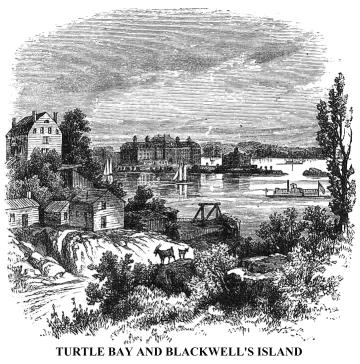 was
taken--was a theatre of some stirring scenes during the revolution. Until
within a few years it remained in its primitive condition--a sheltered cove
with a gravelly beach, and high rocky shores covered with trees and shrubbery.
Here the British government had a magazine of military stores, and these the
Sons of Liberty, as the early Republicans were called, determined to seize,
in July, 1775. A party, under the direction of active members of that association,
proceeded stealthily by water, in the evening, from Greenwich, Connecticut,
passed the dangerous vortex of Hell-gate at twilight, and at midnight surprised
and captured the guard, and seized the stores. The old storehouse in which
they were deposited was yet standing, in 1861, a venerable relic of the past
among the busy scenes of the present.
was
taken--was a theatre of some stirring scenes during the revolution. Until
within a few years it remained in its primitive condition--a sheltered cove
with a gravelly beach, and high rocky shores covered with trees and shrubbery.
Here the British government had a magazine of military stores, and these the
Sons of Liberty, as the early Republicans were called, determined to seize,
in July, 1775. A party, under the direction of active members of that association,
proceeded stealthily by water, in the evening, from Greenwich, Connecticut,
passed the dangerous vortex of Hell-gate at twilight, and at midnight surprised
and captured the guard, and seized the stores. The old storehouse in which
they were deposited was yet standing, in 1861, a venerable relic of the past
among the busy scenes of the present.
At Turtle Bay we fairly meet the city in its gradual movement along the shores of the East River. Below this point almost every relic of the past, in Nature and Art, has been swept away by pick and powder; and wharves, store-houses, manufactories, and dwellings, are occupying places where, only a few years ago, were pleasant country seats, far away from the noise of the town. Our ride in this direction will, therefore, have no special attractions, so let us turn towards the Hudson again, and visit some points of interest in the central and lower portions of the island within the limits of the regulated streets. The allotted space allows us to take only glimpses at some of the most prominent points and objects.
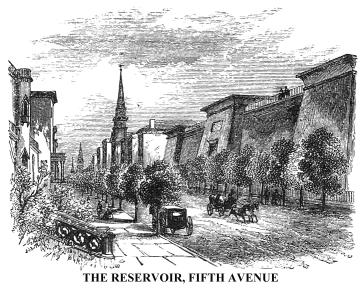 The
great distributing reservoir of the Croton water, upon Murray Hill, between
Fortieth and Forty-second Streets, and Fifth and Sixth Avenues, challenges
our attention and admiration. Up to and beyond this point the Fifth Avenue--the
street of magnificent palatial residences --is completed, scarcely a vacant
lot remaining upon its borders. The reservoir stands in solemn and marked
contrast to these ornamental structures, and rich and gay accompaniments.
Its walls, in Egyptian style, are of dark granite, and average forty-four
feet in height above the adjacent streets. Upon the top of the wall, which
is reached by massive steps, is a broad promenade, from which may be obtained
very extensive views of the city and the surrounding country. This is made
secure by a strong battlement of granite on the outside, and next to the water
by an iron fence.
The
great distributing reservoir of the Croton water, upon Murray Hill, between
Fortieth and Forty-second Streets, and Fifth and Sixth Avenues, challenges
our attention and admiration. Up to and beyond this point the Fifth Avenue--the
street of magnificent palatial residences --is completed, scarcely a vacant
lot remaining upon its borders. The reservoir stands in solemn and marked
contrast to these ornamental structures, and rich and gay accompaniments.
Its walls, in Egyptian style, are of dark granite, and average forty-four
feet in height above the adjacent streets. Upon the top of the wall, which
is reached by massive steps, is a broad promenade, from which may be obtained
very extensive views of the city and the surrounding country. This is made
secure by a strong battlement of granite on the outside, and next to the water
by an iron fence.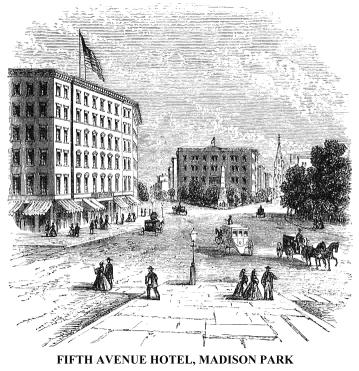
The reservoir covers an area of two acres, and its tank capacity is over twenty millions of gallons. The water was first let into it on the 4th of July, 1842. On the 14th of October following it was distributed over the town, and the event was celebrated on that day by an immense military and civic procession. Such a display had never been seen in New York since the mingling of the waters of the Great Lake and the Hudson River, through the Eric Canal, was celebrated in 1825.
At the request of the Corporation of the City of New York, George P. Morris wrote the following Ode, which was sung near the fountain then playing in the City Hall Park, by the members of the New York Sacred Music Society:--
THE CROTON ODE.
I.
Gushing from this living fountain,
Music pours a falling strain,
As the goddess of the mountain
Comes with all her sparkling train,
From her grotto springs advancing,
Glittering in her feathery spray,
Woodland fays beside her dancing,
She persues her winding way,
II.
Gently o'er the rippling water,
In her coral shallop bright,
Glides the rock-king's dove-eyed daughter,
Decked in robes of virgin white,
Nymphs and Naiads sweetly smiling,
Urge her bark with pearly hand,
Merrily the sylph beguiling
From the Rocks of fairy-land.
III.
Swimming on the snow-curled billow,
See the river spirits fair
Lay their checks, as on a pillow,
With the foam-beads in their hair,
Thus attended, hither wending,
Floats the lovely Oread now,
Eden's arch of promise bending
Over her translucent brow.
IV.
Hall the wanderer from a far land!
Bind her flowing tresses up!
Crown her with a fadeless garland,
And with crystal brim the cup;
From her haunts of deep seclusion,
Let Intemperance greet her too,
And the heat of his seclusion
Sprinkle with this mountain-dew.
V.
Water leaps as if delighted,
While her conquered foes retire!
Pale Contagion flies affrighted
With the baffled demon Fire!
Safety dwells in her dominions,
Health and Beauty with her more,
And entwine their circling pinions
In a sisterhood of love.
VI.
Water shouts a glad hosanna
Bubbles up the earth to bless!
Cheers it like the precious manes
In the barren wilderness.
Here we wondering gaze, assembled
Like the grateful Hebrew based,
When the hidden fountain trembled,
And obeyed the prophet's wand.
VII.
Bound the aqueducts of story,
As the mists of Lethe throng,
Croton's waves in all their glory
Troop in melody along,
Ever sparkling, bright, and single,
Will this rock-ribbed stream appear,
When posterity shall mingle
Like the gathered waters here.
The waters of the Croton flow from the dam to the distributing reservoir, forty miles and a half, through a covered canal, made of stone and brick, at an average depth of 21/2 feet. The usual flow is about 30,000,000 of gallons a day; its capacity is 60,000,000. It passes through sixteen tunnels in rock, varying from 160 to 1,263 feet. In Westchester county it crosses twenty-five streams, from 12 to 70 feet below the line of grade, besides numerous small brooks furnished with culverts. After crossing the Harlem River over the high bridge already described, it passes the Manhattan valley by an inverted siphon of iron pipes, 4,180 feet in length, and the Clendening valley on an aqueduct 1,900 feet. It then enters the first receiving reservoir, now in the Central Park, which has a capacity of 150,000,000 gallons. In a hygienic and economic view, the importance of this great work cannot be estimated; in insurance alone it caused the reduction of 40 cents on every 100 dollars in the annual rates. It is estimated that the capacity of the Croton River is sufficient to supply the city with a population of 5,000,000. The ridge line, or water-shed, enclosing the Croton valley above the dam, is 101 miles in length. The stream is 39 miles is length, and its tributaries 136 miles.* The total area of the valley is 352 square miles; within it are thirty-one natural lakes and ponds.
* The principal one of the remote sources of the Croton River is a spring near the road side, not far from the house of William Hoag, on Quaker Hill, in the town of Pawling. The spring is by the side of a stone fence, with a barrel-curb, and is 1,300 feet above tide water.
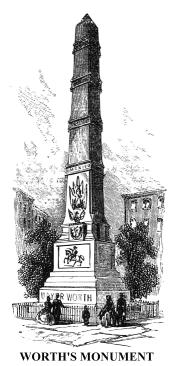 From
the reservoir we ride down Fifth Avenue, the chief fashionable quarter of
the metropolis. For two miles we may pass between houses of the most costly
description, built chiefly of brown freestone, some of it elaborately carved.
Travelers agree that in no city in the world can be found an equal number
of really splendid mansions in a single street; they are furnished, also,
in princely style. The side-walks are flagged with heavy blue stone, or granite,
and the street is paved with blocks of the latter material. At Madison Square,
between Twenty-third and Twenty-sixth Streets, it is crossed diagonally by
Broadway, and there, as an exception, are a few business establishments. At
the intersection, and fronting Madison Park, is the magnificent Fifth Avenue
Hotel, built of white marble, and said to be the largest and most elegant
in the world. As we look up from near the St. Germain, this immense house,
six stories in height, is seen on the left, and the trees of Madison Park
on the right. In the middle distance is the Worth House, a large private boarding
establishment, and near it the granite monument erected by the city of New
York to the memory of the late General William J. Worth, of the United States
army.
From
the reservoir we ride down Fifth Avenue, the chief fashionable quarter of
the metropolis. For two miles we may pass between houses of the most costly
description, built chiefly of brown freestone, some of it elaborately carved.
Travelers agree that in no city in the world can be found an equal number
of really splendid mansions in a single street; they are furnished, also,
in princely style. The side-walks are flagged with heavy blue stone, or granite,
and the street is paved with blocks of the latter material. At Madison Square,
between Twenty-third and Twenty-sixth Streets, it is crossed diagonally by
Broadway, and there, as an exception, are a few business establishments. At
the intersection, and fronting Madison Park, is the magnificent Fifth Avenue
Hotel, built of white marble, and said to be the largest and most elegant
in the world. As we look up from near the St. Germain, this immense house,
six stories in height, is seen on the left, and the trees of Madison Park
on the right. In the middle distance is the Worth House, a large private boarding
establishment, and near it the granite monument erected by the city of New
York to the memory of the late General William J. Worth, of the United States
army.
This is the only public monument in the city of New York, except a mural one to the memory of General Montgomery, in the front wall of St. Paul's Church. It is of Quincy granite; the apex is fifty-one feet from the ground, and the smooth surface of the shaft is broken by raised bands, on which are the names of the battles in which General Worth had been engaged. On the lower section of the shaft are representations of military trophies in relief. General Worth was an aide-de-camp of General Scott in the battles of Chippewa and Niagara, in the summer of 1814, and went through the war with Mexico with distinction. His name holds an honourable place among the military heroes of his country. The monument was erected in 1858.
Copyright © 1998, -- 2004. Berry Enterprises. All rights reserved. All items on the site are copyrighted. While we welcome you to use the information provided on this web site by copying it, or downloading it; this information is copyrighted and not to be reproduced for distribution, sale, or profit.